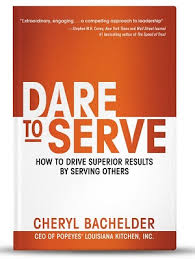Dare to Serve: How to Drive Superior Results by Serving Others
Tanmay Vora

“The first responsibility of a leader is to define reality. The last is to say ‘Thank You’. In between, the leader is a servant.” – Max De Pree
Gone with the industrial age is the concept of traditional leadership where people at the top of pyramid exercise the power in a hierarchy. In a creative and connected economy, a leader’s first and foremost job is to serve to the needs of people they lead. To create an ecosystem where creative people thrive. To create trust by trusting others. To build a learning organization. To deliver meaningful results.
That is what Cheryl Bachelder, CEO of Popeyes® Lousiana Kitchen, Inc says in her brand new book “Dare to Serve – How to Drive Superior Results by Serving Others”.
Why dare? What kind of a leader is Cheryl Bachelder talking about?
“This is a different kind of leader with a rare combination of traits, courageous enough to take the people to a daring destination, yet humble enough to selflessly serve others on the journey. The dynamic tension between daring and serving creates conditions for a superior performance.”
I could see the same contrast/creative tension between “dare” and “serve” that Jim Collins described as “Fierce Resolve” and “Humility” as a trait of Level 5 Leader.
What I like about this book is that it is a first hand account of a CEO who turned the business around. In 2007, Cheryl Bachelder was hired to turn around the business situation that reeled with poor customer service, dwindling sales and troubled relationships with franchise owners. In the first part, Cheryl describes the journey of transformation, challenges, setbacks and ultimately the triumphs. In the second part, she puts forward anecdotes and specific examples of how leaders can become stewards of people and organization’s mission. The book makes you think through game-changing questions that Cheryl calls as “Dare to Serve Reflections”. Exercises and quotes makes the book all the more interesting and learning oriented.
The concepts of servant leadership or the paradoxes of leadership are not new. But Cheryl Bachelder does a great job at bringing these concepts to the fore using her own transformation experience. And for that, this book is valuable.
Here are some of the other gems from the book:
Helping people who want to find meaning and purpose at work is exceptionally rewarding. It is the leader’s opportunity to leave a legacy in lives of people you lead.
For principles to matter, they have to be “in action,” not on plaques. Principles must come alive in the daily conversations, decisions, and actions of the team.
Self-centered leadership is actually a lazy path. The leader merely wields power over others to achieve results for their own benefit. This is not difficult to do. But this approach stunts performance of the people and the enterprise. It cannot deliver superior results.
If you are a leader who is at the center of transformation responsibility, this book is a must read. If you are already someone who already leads through service, this book will help you gain a diverse perspective of what stewardship looks like in real life.
Also Read: Other book reviews/author interviews at QAspire.